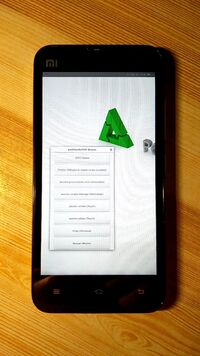Xiaomi Mi 2 (xiaomi-aries): Difference between revisions
Appearance
No edit summary |
No edit summary |
||
| Line 40: | Line 40: | ||
== Maintainer(s) == | == Maintainer(s) == | ||
* [https://t.me/Lwrless Lwrless] | |||
<!-- Only if this device doesn't run on linux-postmarketos yet! --> | <!-- Only if this device doesn't run on linux-postmarketos yet! --> | ||
<!-- This person needs to be willing to answer questions from users of this device --> | <!-- This person needs to be willing to answer questions from users of this device --> | ||
| Line 48: | Line 49: | ||
[[File:Photo 2019-01-21 23-23-18.jpg|300px]] | [[File:Photo 2019-01-21 23-23-18.jpg|300px]] | ||
== Progress == | |||
In [https://gitlab.com/postmarketOS/pmaports/merge_requests/168 !168] I used outdated cm11 kernel from [https://github.com/LineageOS/android_kernel_xiaomi_aries LineageOS], it boots fine but I wasn't able to get the display working. | |||
Then I switched to the kernel which is still maintained by [https://github.com/GuaiYiHu GuaiYiHu] from [https://github.com/MoKee/android_kernel_xiaomi_aries/ MoKee]. By following the steps on [[Troubleshooting:display]] and [[Tuning_sysfs]], the display was enabled. | |||
== Installation == | == Installation == | ||
| Line 53: | Line 60: | ||
== See also == | == See also == | ||
* [https://gitlab.com/postmarketOS/pmaports/merge_requests/ | * [https://gitlab.com/postmarketOS/pmaports/merge_requests/171 !171] Initial merge request | ||
<!-- | <!-- | ||
Link to related gitlab issues or merge requests like the following (replace CHANGEME with the ID, e.g. 1234): | Link to related gitlab issues or merge requests like the following (replace CHANGEME with the ID, e.g. 1234): | ||
Revision as of 04:36, 24 January 2019
| WARNING: This device is not recommended for future use with postmarketOS due to its armhf architecture. Alpine Linux (the distribution that postmarketOS extends) pmaports#599 has been considering dropping it. The processor of the device may support the armv7 architecture. If so, you can modify the device package and change the architecture accordingly. |
 Xiaomi Mi 2 | |
| Manufacturer | Xiaomi |
|---|---|
| Name | Mi 2 |
| Codename | xiaomi-aries |
| Released | 2012 |
| Hardware | |
| Chipset | Qualcomm Snapdragon S4 APQ8064 |
| CPU | Quad-Core Krait @ 1.5 GHz |
| GPU | Adreno 320 |
| Display | 1280x720 IPS |
| Storage | 16GB / 32GB |
| Memory | 2GB |
| Architecture | armhf |
| Software | |
| Original software | MIUI V4 (Android 4.1 Jelly Bean) |
| postmarketOS | |
| Category | testing |
| Pre-built images | no |
| Flashing |
Works |
|---|---|
| USB Networking |
Works |
| Internal storage |
No data |
| SD card |
No data |
| Battery |
No data |
| Screen |
Works |
| Touchscreen |
Works |
| Multimedia | |
| 3D Acceleration |
No data |
| Audio |
No data |
| Camera |
No data |
| Camera Flash |
No data |
| Connectivity | |
| WiFi |
No data |
| Bluetooth |
No data |
| GPS |
No data |
| NFC |
No data |
| Modem | |
| Calls |
No data |
| SMS |
No data |
| Mobile data |
No data |
| Miscellaneous | |
| FDE |
No data |
| USB OTG |
No data |
| HDMI/DP |
No data |
| Sensors | |
| Accelerometer |
No data |
| Magnetometer |
No data |
| Ambient Light |
No data |
| Proximity |
No data |
| Hall Effect |
No data |
| Haptics |
No data |
| Barometer |
No data |
Contributors
- Lwrless
Maintainer(s)
How to enter flash mode
Volume Down + Power, it will look like this:
Progress
In !168 I used outdated cm11 kernel from LineageOS, it boots fine but I wasn't able to get the display working.
Then I switched to the kernel which is still maintained by GuaiYiHu from MoKee. By following the steps on Troubleshooting:display and Tuning_sysfs, the display was enabled.
Installation
See also
- !171 Initial merge request
